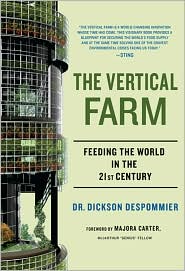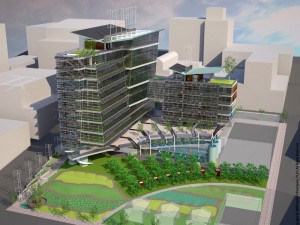 I switched gears this week and spent some time learning about ways the world can feed a burgeoning population. One emerging idea is through a “vertical farm,” an idea that has been promoted by Dr. Dickson Despommier, a former professor of microbiology and public health in environmental sciences at Columbia. He recently authored, “The Vertical Farm Feeding the World in the 21st Century,” which lays out the idea of growing our food vertically in greenhouse skyscrapers, rather than spread out over hundreds of millions of acres of farmland.
I switched gears this week and spent some time learning about ways the world can feed a burgeoning population. One emerging idea is through a “vertical farm,” an idea that has been promoted by Dr. Dickson Despommier, a former professor of microbiology and public health in environmental sciences at Columbia. He recently authored, “The Vertical Farm Feeding the World in the 21st Century,” which lays out the idea of growing our food vertically in greenhouse skyscrapers, rather than spread out over hundreds of millions of acres of farmland.
This idea has really captured my fancy and got my head spinning around all the ways it could be carried out. But let me take a step back. Today, our food travels on average 1,500 miles from field to table. Crazy. Much of our produce and fruits come from places like Mexico and South America. Wouldn’t it be cool if they could come from your own city?
That is exactly what Despommier is promoting. In the middle of an urban area could be a “vertical farm” that grows produce, fruits and grains and houses things such as fish farms. These future farms would grow our food year round while the excess waste, or biomass could be used to produce bioelectricity and biofuels. In fact, Despommier says that in some cases, a vertical farm could have up to five harvests per year.
He writes that ideally, they would be cheap to build, modular, durable, easily maintained, and safe to operate. A vertical farm would mitigate external influences on crops such as too much rain or drought and disease along with the need for fertilizers, herbicides or pesticides. Vertical farms would provide well-paying jobs and improve economics. He also believes they should be independent of economic subsidies and outside support once they are up and running and they should be profitable.
Other advantages include:
- • allowance for ecosystem restoration
- • use of 70-95 percent less water (70 percent of all water used globally is for agriculture and 20 percent of all fossil fuels are used in the ag sector)
- • no agricultural runoff
- • greatly reduce food miles
- • more control of food safety and security
- • purification of grey water to drinking water
- • animal feed from postharvest plant material
 While today no one has actually built a vertical farm, designers around the world have provided concepts of what they would look like. Despommier writes that there are four major themes that designers and engineers must include: capture sunlight and disperse it evenly among the rocks (one way to capture sunlight is through solar energy); capture passive energy for supplying a reliable source of energy (could be wind or geothermal); employ a good barrier design for plant production; and maximize the amount of space devoted to growing crops.
While today no one has actually built a vertical farm, designers around the world have provided concepts of what they would look like. Despommier writes that there are four major themes that designers and engineers must include: capture sunlight and disperse it evenly among the rocks (one way to capture sunlight is through solar energy); capture passive energy for supplying a reliable source of energy (could be wind or geothermal); employ a good barrier design for plant production; and maximize the amount of space devoted to growing crops.
With land and water at a premium, increased environmental concerns, growing concerns over energy, and the need to grow more food throughout the world, Despommier’s vertical farm may just be one viable part of the solution. It is well-worth the read.

